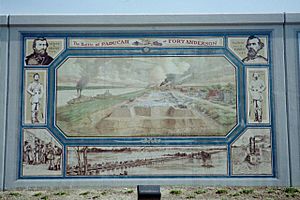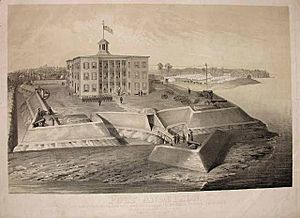Fort Anderson (Kentucky) facts for kids
Fort Anderson was an important military base located in Paducah, Kentucky. It was the place where the Battle of Paducah happened during the American Civil War.
This fort was first a place to store supplies. Later, it was rebuilt into a strong fort with seven cannons. Fort Anderson was about 400 feet long and stretched 160 feet towards the Ohio River. It was protected on three sides by wide ditches, 50 feet across, filled with water. About 665 soldiers were stationed there, led by Colonel Stephen G. Hicks.
Contents
Confederate Plans
In March 1864, Confederate Major-General Nathan Bedford Forrest began a mission from Columbus, Mississippi. He led a group of less than 3,000 soldiers into West Tennessee and Kentucky. His goals were to find new recruits, get supplies, and challenge the Union forces.
He arrived in Paducah on March 25. His cavalry quickly took control of the town. They destroyed supplies they didn't need and took what they wanted, especially horses and mules.
Union Refusal to Surrender
Fort Anderson was defended by Union officers Colonel Stephen G. Hicks and Lieutenant Commander James W. Shirk. They had help from two gunboats on the Ohio River. They were determined not to give up the fort.
General Forrest sent a message to Colonel Hicks, demanding that he surrender the fort without conditions. Here is what Forrest's letter said:
Colonel:
I have enough soldiers to take your fort and win this battle. To avoid unnecessary bloodshed, I demand that you surrender the fort and your troops, along with all government property. If you surrender, you will be treated as prisoners of war. But if I have to attack, you should expect no mercy.
N.B. Forrest,
Major-General, Commanding Confederate Troops.
Colonel Hicks wrote back with his own letter. It said:
Sir:
I just received your message. You demand that I surrender the soldiers under my command without conditions. I must tell you that the government placed me here to defend this post. I believe it is my duty as an honorable officer to follow all orders from my superiors. Therefore, I must respectfully decline your demand to surrender.
S.G. Hicks
Colonel, Commanding Post
The Attack on Fort Anderson
Because Colonel Hicks refused to surrender, General Forrest ordered an attack. On March 25, 1864, at 4:30 PM, the Confederate cavalry charged the fort. Colonel Albert P. Thompson, who was from Paducah, led the attack.
The Union soldiers inside the fort and on the gunboats fired back with powerful shots. The Confederates were forced to fall back. They charged again, but met the same strong defense. Some Confederates then entered nearby homes and fired from behind the buildings. General Forrest eventually ordered his troops to stop firing.
Aftermath of the Battle
Even though this event is often seen as a Confederate victory, it did not cause any major or lasting changes in the war.



